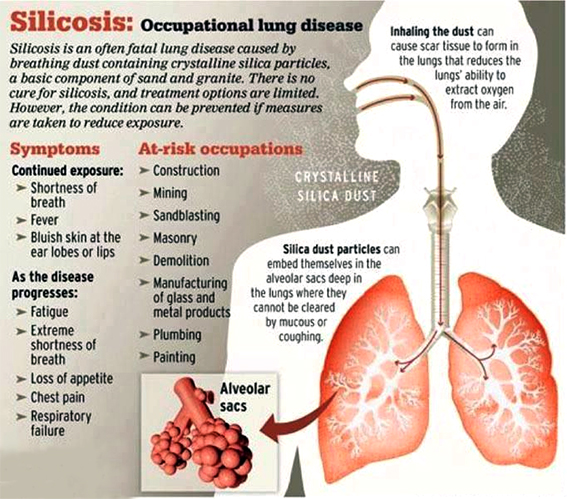Governance
Silicosis
- 14 Oct 2021
- 6 min read
Why in News
In India, countless workers engaged in mines, construction and factories are silently dying of exposure to dust. This is better referred to as silicosis.
- Silicosis can be described as an occupational disease or hazard due to dust exposure. It is incurable and can cause permanent disability.
- However, it is totally preventable by available control measures and technology.
Key Points
- About Silicosis
- Silicosis occurs most commonly in people working in the quarrying, manufacturing, and building construction industries.
- Silica (SiO2/silicon dioxide) is a crystal-like mineral found in abundance in sand, rock, and quartz.
- It is a progressive lung disease caused by the inhalation of silica over a long period of time, characterized by shortness of breath, cough, fever and bluish skin.
- It is one of the most prevalent occupational health illnesses in the world. It is also reported from the population with non-occupational exposure to silica dust from industrial as well as non-industrial sources.
- Exposure to large amounts of free silica may not be noticed because silica is odourless, non-irritant and does not cause any immediate health effects, but long-term exposure is associated with pneumoconiosis, lung cancer, pulmonary tuberculosis, and other lung diseases.
- Pneumoconiosis is one of a group of interstitial lung diseases caused by breathing in certain kinds of dust particles that damage your lungs.
- Diagnosis is a challenge because it is difficult to even find out if a person has tuberculosis or silicosis.
- The nodules that collect to form a mass can take up to 20 years to be identified in chest x-rays and the victim notices symptoms only after many years of exposure to silica.
- Grossly, silicotic nodules are firm, discrete, rounded lesions that contain a variable amount of black pigment.
- The nodules tend to occur around respiratory bronchioles and small pulmonary arteries.
- In India silicosis is prevalent in Gujarat, Rajasthan, Pondicherry, Haryana, Uttar Pradesh, Bihar, Chhattisgarh, Jharkhand, Orissa and West Bengal among the workers of construction and mining.
- Silicosis occurs most commonly in people working in the quarrying, manufacturing, and building construction industries.
- Steps Taken by The Government
- Legal Protections: Silicosis is a notified disease under the Mines Act (1952) and the Factories Act (1948).
- Factory Act of India (1948) mandates a well-ventilated working environment, provisions for protection from dust, reduction of overcrowding and provision of basic occupational health care.
- Silicosis Portal: A ‘silicosis portal’ was hosted by the Department of Social Justice and Empowerment.
- Self-Registration: A system of worker self-registration, diagnosis through district-level pneumoconiosis boards and compensation from the District Mineral Foundation Trust (DMFT) funds to which mine owners contribute.
- Occupational Safety, Health, and Working Condition Code 2020 (OSHWC):
- The code makes it mandatory for all employers to provide annual health checks free of cost as prescribed by the appropriate Government.
- Legal Protections: Silicosis is a notified disease under the Mines Act (1952) and the Factories Act (1948).
- Associated Challenges
- Low rates of notification: Low rates of notification of silicosis by the mining sector. Most of the time silicosis is diagnosed as tuberculosis.
- Inhuman Cycle: Present system is designed to consume workers in the mining sector and dispense them with small compensation and replace them with next able workers.
- Loopholes in OSHWC Code: The code places no obligation on the mine owner to provide any form of rehabilitation in terms of alternative employment in the mine, or payment of a disability allowance/lump sum compensation for a worker found medically unfit.
- Underutilized Funds: The DMFT funds are both underutilised and spent in an entirely ad hoc manner.
Way Forward
- Rajasthan Model: Rajasthan has one of the top-most shares of over 17% in value of mineral production in the country and a long history of civil society activism.
- Given this, Rajasthan became the first to notify silicosis as an ‘epidemic’ in 2015.
- Further, in 2019, it announced a formal Pneumoconiosis Policy, only next to Haryana.
- This model can be implemented by other mineral producing states also.
- Proper Implementation of OSHWC: The State rules under the OSHWC Code must take care to ensure the health checks are provided to all workers in all establishments, irrespective of age.
- Incentivizing Local Manufacturers: Local manufacturers must be incentivised to innovate and develop low-cost dust-suppressant and wet-drilling mechanisms that could either be subsidised or provided free of cost to the mine owners.







